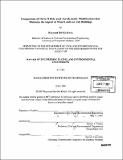Comparison of three widely-used aerodynamic modifications that minimize the impact of wind loads on tall buildings
Author(s)
Kwok, Raymond Hoi-Kit
DownloadFull printable version (9.063Mb)
Alternative title
Comparison of 3 widely-used aerodynamic modifications that minimize the impact of wind loads on tall buildings
Other Contributors
Massachusetts Institute of Technology. Dept. of Civil and Environmental Engineering.
Advisor
Jerome J. Connor.
Terms of use
Metadata
Show full item recordAbstract
For tall buildings, motion caused by wind is usually the most damaging to the lateral support system. As a result, engineers have invented many different methods to limit the motion of the buildings, for example dampers, bracings and outriggers etc. Aerodynamic modification, which is a passive approach, can also be used to reduce the impacts of wind loads. In this thesis, three widely-used aerodynamics modifications are discussed: 1) Shaping the corners of buildings, 2) Addition of openings through buildings and 3) Optimizing cross-sectional shapes of buildings. Comparison based on five criteria related to economy, sustainability, appearance, ease of construction and effectiveness in suppressing response of buildings caused by wind, is performed. With the help of a comparison matrix, it is shown that for a building located in downtown Boston, the method based on optimizing cross-sectional shapes is the best option.
Description
Thesis (M. Eng.)--Massachusetts Institute of Technology, Dept. of Civil and Environmental Engineering, 2007. Includes bibliographical references (leaves 59-60).
Date issued
2007Department
Massachusetts Institute of Technology. Department of Civil and Environmental EngineeringPublisher
Massachusetts Institute of Technology
Keywords
Civil and Environmental Engineering.